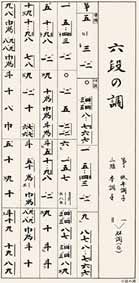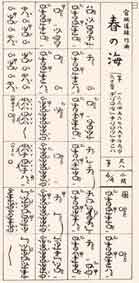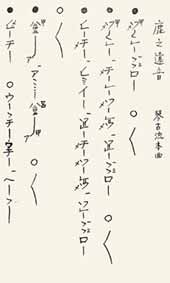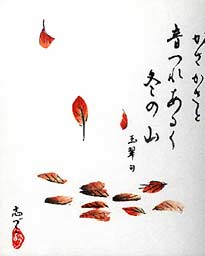
Japanese
Instruments
Koto
 Of Chinese origin, the koto is table
zither 2 meters in length. It came to Japan during the Nara Period (553-794).
It is one of the few musical instruments to be typically of Chinese origin.
The other Chinese instruments that came to Japan originated in Central
Asia. In China, we find two types of table zither: one with and one without
bridges. The koto is derived from the former instrument. Originally, the
Japanese word "koto" referred to all plucked instruments. Later
on, the name came to designate the table zither. During the Nara period,
there existed two table zitehrs in Japan: the gaku-so, with 12
or 13 strings, and the wagon with 6 strings. The gaku-so
was used in the Gagaku Court music. The instrument is played with picks,
called tsume, on the thumb, the index and the middle finger.
A 2-stringed version, the nigenkin, also exists, as well as a
single stringed one, the ichigenkin. We can also find a 17-stringed
bass koto which was created at the beginning of the 20th century by the
well-known composer and koto player Michio Miyagi, as well as 20, 25 and
30-stringed versions.
Of Chinese origin, the koto is table
zither 2 meters in length. It came to Japan during the Nara Period (553-794).
It is one of the few musical instruments to be typically of Chinese origin.
The other Chinese instruments that came to Japan originated in Central
Asia. In China, we find two types of table zither: one with and one without
bridges. The koto is derived from the former instrument. Originally, the
Japanese word "koto" referred to all plucked instruments. Later
on, the name came to designate the table zither. During the Nara period,
there existed two table zitehrs in Japan: the gaku-so, with 12
or 13 strings, and the wagon with 6 strings. The gaku-so
was used in the Gagaku Court music. The instrument is played with picks,
called tsume, on the thumb, the index and the middle finger.
A 2-stringed version, the nigenkin, also exists, as well as a
single stringed one, the ichigenkin. We can also find a 17-stringed
bass koto which was created at the beginning of the 20th century by the
well-known composer and koto player Michio Miyagi, as well as 20, 25 and
30-stringed versions.
By the 17th century koto was used to accompany dances and became part
of small chamber ensembles. Previously, it was used only to accompany
the voice. A new repertoire was then created, but based on the shamisen
one (the shamisen being a 3-stringed lute covered either with snake, cat
or dog skins). In fact, the shamisen repertoire has been the source for
the repertoire of chamber music. Following these changes, the koto became
a very popular instrument.
In the 20th century, some musicians modernized the playing of the koto
based on Western music ideas. The first instigator was the composer and
koto player Michio Miyagi, a musician who became blind at the age of 6.
He died in 1957. Another musician who also modernized more the playing
of the koto was composer/player Tadao Sawai.
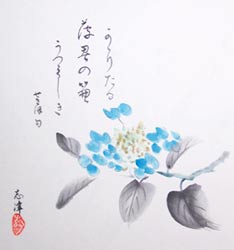
Shakuhachi
 As
with the koto, the shakuhachi came to Japan from China with the Gagaku
Court music. At that time, it had 6 holes, similarly to today's Chinese
xiao. During the 9th century, it was removed from the Gagaku
ensemble. A century later, four Chinese monks were invited to Japan to
teach the xiao to Japanese monks. A 5-hole version was created
around the time. By the 13th century, the monks of the Buddhist Fuke sect
began using the shakuhachi as a replacement for the voice in sutra chanting.
As
with the koto, the shakuhachi came to Japan from China with the Gagaku
Court music. At that time, it had 6 holes, similarly to today's Chinese
xiao. During the 9th century, it was removed from the Gagaku
ensemble. A century later, four Chinese monks were invited to Japan to
teach the xiao to Japanese monks. A 5-hole version was created
around the time. By the 13th century, the monks of the Buddhist Fuke sect
began using the shakuhachi as a replacement for the voice in sutra chanting.
During the Edo period (1615-1868),
the shakuhachi went through major changes. Being similar to the Chinese
xiao, it was thin and long. Shakuhachi makers started to use a thicker
bamboo. At the time, the shogun was able to unify the country and establish
peace. Samourai suddently had nothing to do: they could no longer fight.
Many became ronin, masterless samourai, and joined the ranks
of roving monks called komuso. They were begging, whilst playing
on the street, wearing a straw hat which hid their identity. Disguised
as komuso, the ronin became spies, using their shakuhachi
at times as a weapon. It has been suggested that the ronin
were behind these major changes in the design and construction of the
shakuhachi.
In the 20th century, the shakuhachi went through other changes. A new
style of playing was created, greatly influenced by Western ideas. At
the end of the 1950s, a 7 hole shakuhachi was created in the hope that
it could be used to play Western music, but this did not attract the
interest of shakuhachi player, either Japanese or Westerners, and the
5 hole version remains the most popular. The 7 hole is often used to
perform folk songs. Another important change is the increasing number
of Westerners playing the shakuhachi today.
If you want to know more about these two instruments, and on the history of Japanese music, please go to the Articles page, in which you can access an article I published on the Musical Traditions Web site.
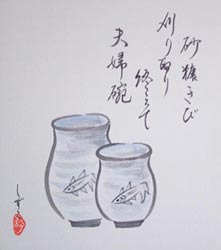
Koto
and Shakuhachi Notations
The musical notation of Japanese traditional music
is very different from Western notation, although the Japanese notation
has been slightly influenced by it in the 20th century. This tradition
notation is still used today. But we also find sometimes scores written
in Western notation.
One of the first points to mention of Japanese notation is that each instrument
has its own individual notation. The notes of a koto score are represented
by numbers indicated the strings of the instruments. The strings from
1 to 10 are represented by the Chinese number 1 to 10 (starting from the
lowest string), while 3 characters have been created for the 3 other strings.
On the hand, the notes of a shakuhachi score are represented by characters
which refers to fingerings. Few notes can be produced using different
fingerings (and different timbres); a character is used for each of these
fingerings. Moreover, scores are read from up-down, right to left, as
traditional Japanese writing.
Here are examples of Japanese notations for the koto and the shakuhachi. To these scores in regular sizes, please click on each one of them.

